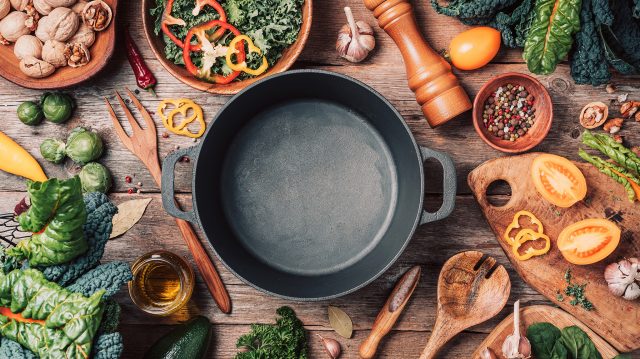
Combining pantry staples with fresh ingredients is a key to creating healthful, appealing meals during the ongoing health crisis, University of Mississippi food experts and nutritionists recommend. Adobe Stock photo
OXFORD, Miss. – As the country slowly continues reopening for business during the COVID-19 pandemic, University of Mississippi food experts and registered dietitians are weighing in on the food supply chain, sharing local sourcing, gardening and home cooking as solutions for issues of food preparation and safety.
To better cope with the impact of the pandemic on the food industry, consumers need to first understand how the food supply-and-demand process functions, advise Jim Taylor, associate professor of hospitality management and director of the online master’s program in hospitality management; and Laurel Lambert, associate professor of nutrition and registered dietitian.
“There’s not really a food shortage per se, but what happened in the supply chain is all of these primary purchasers of dairy and proteins have been shut down,” Taylor said. “When the restaurants shut down, there was no vehicle to change these delivery methods and packaging such that it would hit the retailers and then us consumers.
“So, the producers stopped producing and the supply chain came to a halt. Now that restaurants are opening up, the supply chain is getting back to normal, but it’s about a three-week lag from the field to the plate.”
The fear that there’s no meat and dairy in the pipeline has caused retailers to increase prices for consumers, Taylor said.
“The processing plants shutting down or the number of them isn’t the problem,” he said. “Dairy farmers are pouring milk out, just throwing it away, because the No. 1 dairy purchaser as a group were restaurants.
“Once they closed, then the grocery stores decided that they would put a cap on how much dairy people were buying, and there was no way to get the dairy from the farms to the tables.”

Consumers need to shop smart and focus on shelf-stable ingredients to stretch their food dollars further during the health crisis, UM food experts advise. Adobe Stock photo
One of the new big trends nationally is for consumers to match up with local farmers. For example, if two people want to split a cow, they can go ahead and buy it from one of the slaughterhouses, which can ship the meat to the buyers already butchered.
“It’s happening locally, but it’s small-scale,” Taylor said. “It’s like putting a Band-Aid on the problem until consumers start purchasing foods at restaurants at a level they did before and restaurants start purchasing products comparable to what they did in the past.”
As the food supply chain is being reimagined, food preparation also is.
“Home cooking has definitely increased during this time,” Lambert said. “I think people will be challenged on what to do with the leftovers from the meals and the leftover ingredients. For example, what do you do with the leftover half-head of cabbage? What about leftover egg whites? When should you freeze food or throw it out?
“I also think they may be shocked at their grocery bill. So, shopping more economically or being more thrifty when buying groceries may be needed.”
An increasing number of people are gardening and growing their own vegetables. As the pandemic lingers, Lambert said she sees a tremendous need and opportunity to educate the public on what to do with all the produce they grow.
“People need to learn how to can and freeze produce and still maintain nutritional value and texture,” she said. “With an increase in home cooking, there is also the need for education on food safety, knife handling skills, food temperatures and handling to prevent food-borne illnesses.”
Lambert offered one major suggestion on how people can make their food supplies last longer.
“Try purchasing shelf-stable foods, such as canned foods and foods such as dried beans and rice, which will have the longest duration,” Lambert said.
Other suggestions submitted by Lambert from a Food and Culinary Specialists newsletter include:
- Stock and shop the pantry, fridge and freezer. Before heading to the grocery store, take stock of what you have in your pantry, fridge and freezer. Use up what you have before buying more.
- Create a staples list for each food storage zone. Stock plenty of foods with long shelf lives so that a meal is never far away.
- Repurpose ingredients through the week and batch cook. Find ideas on meal planning, including using apps or a simple pen and paper.
- Shop smart. Look for sales, shop seasonally, utilize discount stores and grow your own food.
- Consider sharing food with family, friends or neighbors.
- Buy store brands, shop online and try not to shop without a list. At the store, look at unit cost to help choose the least expensive product.
- Use your freezer to save meals and other foods that might otherwise go bad. Make sure you can see all the food you have on hand.
- Use clear containers, if possible. Label and date food. Put older food toward the front so that it will be used first.